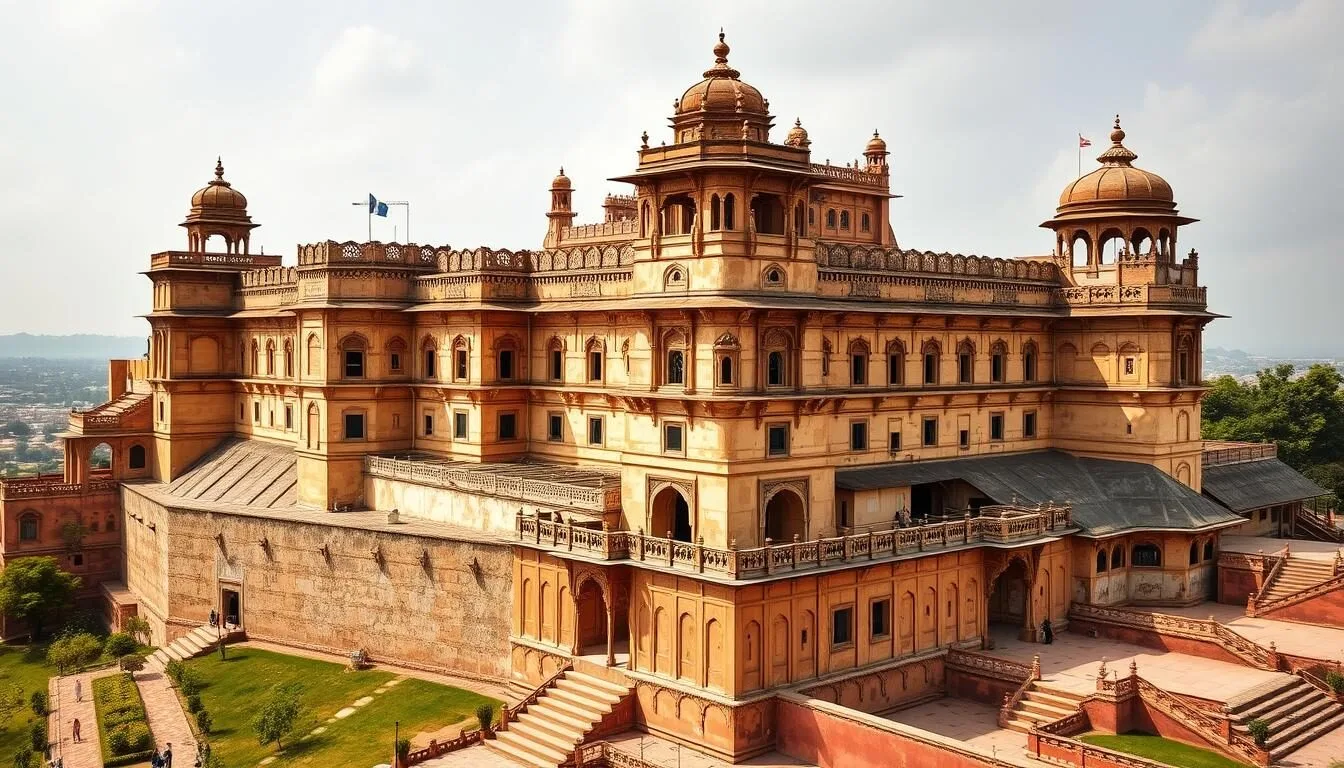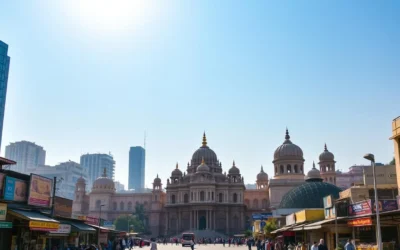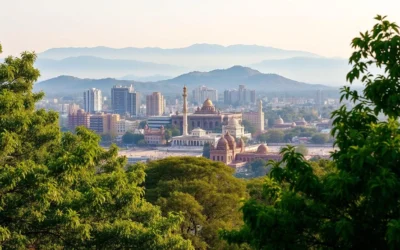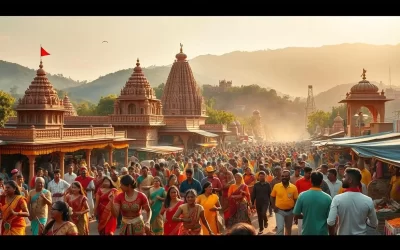✓ Accommodations✓ Flights✓ Rental Cars
Discover the Rich Heritage of Gwalior
As one of central India’s most captivating historical cities, Gwalior is a perfect blend of architectural marvels and royal heritage. Located in Madhya Pradesh, this ancient city boasts impressive monuments that tell stories of powerful dynasties and artistic achievements spanning centuries.
Gwalior stands out as a premier tourist destination in Madhya Pradesh, offering visitors a unique blend of history, culture, and spiritual experiences. The city’s historical significance is evident in its architectural wonders, such as the Gwalior Fort, which is perched atop a rocky plateau.
The city presents a fascinating journey through India’s royal past, from the magnificent Gwalior Fort to the opulent Jai Vilas Palace. Beyond its famous landmarks, Gwalior offers spiritual sites, museums, and local markets that provide deeper insights into the region’s cultural fabric.
This comprehensive guide will take you through Gwalior’s must-visit attractions, hidden gems, and practical travel tips to help you plan an unforgettable exploration of this historical treasure.
- Gwalior stands as one of central India’s most captivating historical cities, offering visitors a perfect blend of architectural marvels, royal heritage, and cultural experiences.
- Located in Madhya Pradesh, this ancient city boasts impressive monuments that tell stories of powerful dynasties and artistic achievements spanning centuries.
- From the magnificent Gwalior Fort perched atop a rocky plateau to the opulent Jai Vilas Palace, Gwalior presents a fascinating journey through India’s royal past.
- Beyond its famous landmarks, the city offers spiritual sites, museums, and local markets that provide deeper insights into the region’s cultural fabric.
- This comprehensive guide will take you through Gwalior’s must-visit attractions, hidden gems, and practical travel tips to help you plan an unforgettable exploration of this historical treasure.
Discovering the Historical Gem of Central India
As you step into Gwalior, you’re immediately immersed in a world of historical significance and cultural richness. This city is a treasure trove of experiences waiting to be uncovered.
A Brief History of Gwalior
Gwalior’s history is as fascinating as it is complex, with roots tracing back to the 8th century. The city has been a historical site of great importance, witnessing the rise and fall of various dynasties. Its strategic location made it a prized possession for rulers throughout history.

Why Gwalior Should Be on Your Travel Radar
Gwalior is a destination that promises an enriching travel experience. You can explore its majestic forts palaces, such as the Gwalior Fort, which stands as a testament to the city’s architectural heritage. Unlike more crowded destinations, Gwalior offers a serene environment to tour Gwalior at your own pace. The city’s unique blend of cultures, its vibrant markets, and its beauty make it an ideal places visit for those looking to experience the authentic essence of central India.
The city’s cultural landscape is a perfect blend of Hindu, Muslim, and Jain influences, making it a fascinating place to explore. From its historical monuments to its cultural traditions, Gwalior is a city that will captivate your senses and leave you with unforgettable memories.
Exploring the Magnificent Gwalior Fort
As you step into the Gwalior Fort, you’re immediately transported to a world of historical grandeur. The fort, a significant landmark in Madhya Pradesh, is home to several architectural marvels that are sure to captivate your imagination.
Man Mandir Palace: The Jewel of Gwalior Fort
Man Mandir Palace is a stunning example of the architectural prowess of the Tomar dynasty. Built in the 15th century, this palace is renowned for its intricate stonework and beautiful designs. The palace’s architecture is a blend of Rajput and Mughal styles, making it a unique and fascinating structure to explore.
Teli Ka Mandir and Its Unique Architecture
Teli Ka Mandir, a temple within the fort complex, is notable for its distinctive architecture. The temple’s design is a mix of Hindu and Jain influences, showcasing the religious tolerance and diversity of the region. Its unique blend of architectural styles makes it a compelling visit for those interested in historical structures.
Saas Bahu Temple: A Masterpiece of Stone Carvings
The Saas Bahu Temple, also known as the Sahastrabahu Temple, is a masterpiece of stone carvings. This temple complex consists of two adjacent structures dedicated to Lord Vishnu, featuring intricate carvings that depict various incarnations of Vishnu, celestial beings, and scenes from Hindu mythology. The temples are a testament to the craftsmanship of the artisans of the 11th century.
The Gwalior Fort is a must-visit destination for anyone interested in history, architecture, and culture. With its rich heritage and stunning monuments, the fort offers a glimpse into the region’s glorious past.
Royal Grandeur at Jai Vilas Palace and Scindia Museum
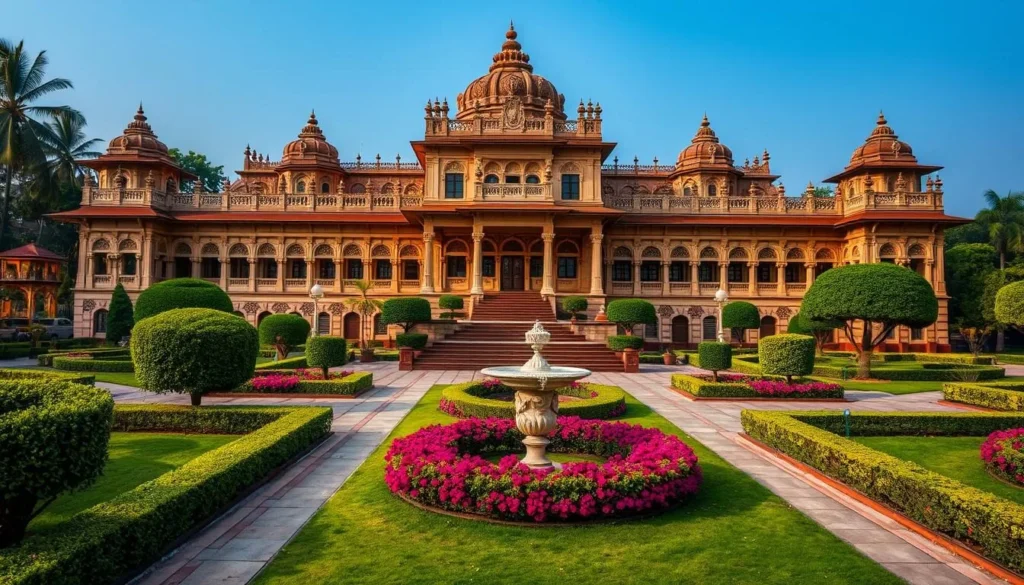
As you step into the grandeur of Jai Vilas Palace, you’ll be transported to a world of royal opulence. This magnificent palace, built in the 19th century, is a testament to the rich history and cultural heritage of Gwalior. Part of the palace has been converted into the Scindia Museum, which houses a remarkable collection of artifacts from the royal family.
The Opulent Durbar Hall and Crystal Staircase
The Durbar Hall, with its intricately designed ceiling and crystal chandeliers, is a masterpiece of Indo-European architecture. The hall’s grandeur is further enhanced by the crystal staircase, which adds a touch of elegance to the overall decor. You can almost imagine the royal ceremonies and state functions that once took place here, surrounded by the opulence of the Scindia dynasty.
Fascinating Exhibits at the Scindia Museum
The Scindia Museum occupies 35 of the 400 rooms in Jai Vilas Palace, offering visitors a glimpse into the lavish lifestyle of one of India’s most powerful princely families. Among the museum’s most celebrated exhibits is the silver model train that once circled the maharaja’s dining table, delivering cigars, port, and after-dinner drinks to guests. The armory section displays an impressive collection of historic weapons, including swords used by Mughal emperors and jewel-encrusted firearms.
The museum also houses an extensive collection of royal costumes, including the former maharani’s French gowns and traditional Indian attire adorned with precious gems. Additionally, the museum showcases an eclectic collection of gifts received by the Scindia family from international dignitaries, including Japanese porcelain and Venetian glassware.
Gujari Mahal: Unveiling Gwalior’s Archaeological Treasures
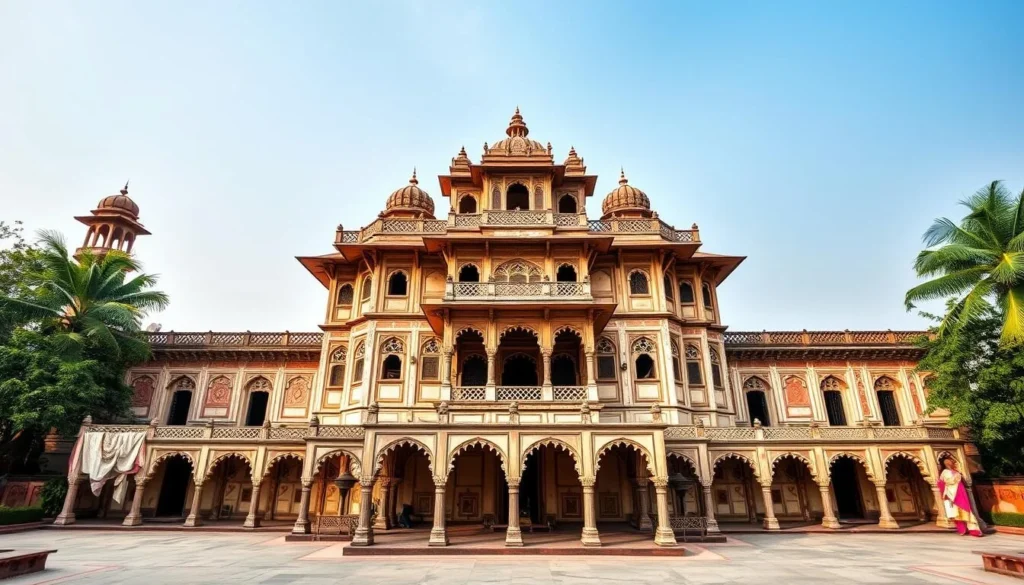
In the heart of Gwalior lies Gujari Mahal, a palace that encapsulates the romance and architectural ingenuity of the era of Raja Man Singh. This 15th-century monument is a testament to the king’s love for his Gujar princess, Mrignayani.
Notable Artifacts and Collections
Gujari Mahal now serves as an archaeological museum, housing a vast collection of artifacts that tell the story of Gwalior’s rich past. The museum’s collections include sculptures, inscriptions, and other antiquities that highlight the region’s cultural and historical significance.
The Love Story Behind the Palace
The story of Gujari Mahal is deeply intertwined with the love story of Raja Man Singh and his queen. According to legend, the king built this palace to fulfill his queen’s demand for a continuous water supply, showcasing not only his love but also his engineering prowess. The palace’s architecture, with its secluded balconies and intimate gardens, reflects the taste and preferences of Mrignayani, the Gujar princess for whom it was built.
Spiritual and Cultural Landmarks of Gwalior
As you explore Gwalior, you’ll discover a mix of spiritual and cultural landmarks that are steeped in history. These sites not only reflect the city’s rich cultural heritage but also offer insights into its spiritual significance.
Tomb of Tansen: A Musical Pilgrimage
The Tomb of Tansen is a revered site for music lovers. Tansen, one of the Navaratnas in Akbar’s court, was a legendary musician whose legacy continues to inspire. The tomb is a simple yet elegant structure that attracts musicians and music enthusiasts from across the country.
Tomb of Ghaus Mohammed: Architectural Marvel
The Tomb of Ghaus Mohammed is another significant landmark that showcases exceptional Mughal architecture. The tomb’s intricate design and grandeur make it a must-visit site in Gwalior.
Gopachal Parvat: Ancient Jain Rock Sculptures
Gopachal Parvat is renowned for its massive rock-cut Jain sculptures, featuring over 100 figures ranging from 2 to 15 meters in height. These sculptures, primarily carved during the 15th century, are a testament to the artistic skill and religious devotion of the time.
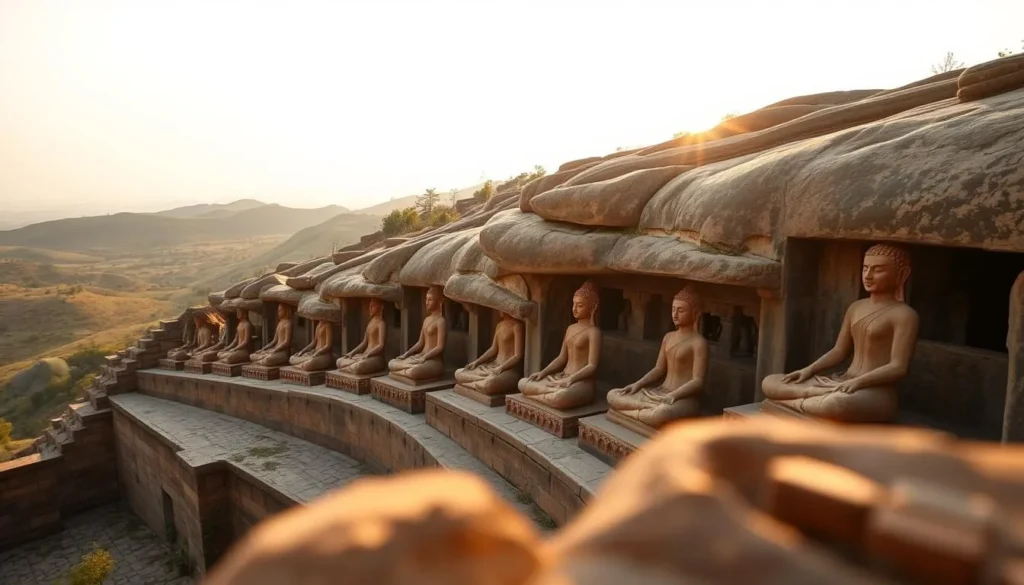
| Landmark | Description | Significance |
|---|---|---|
| Tomb of Tansen | A simple yet elegant tomb honoring the legendary musician Tansen. | Revered by music lovers, reflecting Gwalior’s musical heritage. |
| Tomb of Ghaus Mohammed | A magnificent Mughal architectural marvel. | Showcases the grandeur of Mughal architecture. |
| Gopachal Parvat | Features massive rock-cut Jain sculptures. | A significant Jain religious site, highlighting ancient carvings. |
Gwalior, Madhya Pradesh: Best Things to Do Beyond the Monuments
Gwalior is more than just its monuments; it offers a plethora of experiences waiting to be discovered. As you plan your trip to this historic city, consider exploring its cultural and spiritual gems.
Sarod Ghar: Museum of Music
Sarod Ghar, the museum of music, is a must-visit place for music enthusiasts. It showcases the history and evolution of Indian classical music, with a collection of instruments and artifacts.
Sun Temple: A Modern Spiritual Haven
The Sun Temple is a modern spiritual haven in Gwalior, offering a serene atmosphere for meditation and reflection. Its unique architecture is a testament to the city’s rich cultural heritage.
Local Shopping and Handicrafts
Gwalior is renowned for its handicrafts, particularly stone carvings, textiles, and pottery. You can find unique souvenirs at Patankar Bazaar and Sarafa Bazaar, making your trip even more memorable. When exploring these markets, you’ll discover things Gwalior is known for, such as chanderi and maheshwari fabrics, and local pottery.

Practical Travel Tips for Your Gwalior Adventure
To ensure a smooth and enjoyable journey to Gwalior, here are some practical travel tips you should consider. Gwalior is a city that seamlessly blends history with modernity, and being prepared will enhance your experience.
Best Time to Visit Gwalior
The best time to visit Gwalior is from October to March when the weather is pleasant, making it ideal for exploring the city’s historical sites, including its magnificent forts and palaces. Avoid visiting during the peak summer months if you can, as the heat can be quite intense.
Getting Around the City
Gwalior is relatively easy to navigate, with options ranging from auto-rickshaws to local buses. You can also hire a taxi or use ride-sharing services for convenience. If you prefer to explore at your own pace, consider renting a car or bike for the day to visit various attractions.
Where to Stay and Eat in Gwalior
Gwalior offers a range of accommodation options to suit every budget. You can eat Gwalior‘s famous street food at places like Chatori Gali and Sarafa Bazaar, where local delicacies are prepared fresh throughout the day. For a place to stay, consider luxury heritage hotels like the Taj Usha Kiran Palace, or opt for budget-friendly guesthouses in the city center. When planning your tour of Gwalior, make sure to include a visit to its renowned eateries.

Conclusion: Why Gwalior Deserves More Than a Day Trip
As you explore Gwalior, you’ll discover that its true beauty lies not just in its monuments, but in the everyday rhythms of life in this historic Indian city. The city’s numerous historical sites, including the magnificent Gwalior Fort and the opulent Jai Vilas Palace, truly require at least two to three days to appreciate fully.
Beyond the major attractions, Gwalior’s layers of history reveal themselves slowly to those who linger. You can experience the city’s living musical traditions by catching an evening performance or visiting specialized museums. The surrounding region of Madhya Pradesh offers complementary experiences, with nearby attractions like the Bateshwar temple complex and Chambal Wildlife Sanctuary.
Gwalior retains an authentic character, allowing visitors to observe daily life in a historic Indian city. The city’s relative affordability means that extending your stay adds minimal cost while maximizing your experience. With visible but unobtrusive law enforcement around major monuments, you can explore at your own pace. As one of the state of Madhya Pradesh’s most accessible historical cities, Gwalior serves as an excellent introduction to central India’s cultural heritage.
In conclusion, Gwalior is a place that warrants more than just a day trip. Whether you’re a history buff, a music enthusiast, or simply a curious traveler, Gwalior has something to offer. So, take your time, and let the city’s beauty and charm unfold before you.
—
The above is subject to change.
Check back often to TRAVEL.COM for the latest travel tips and deals.
